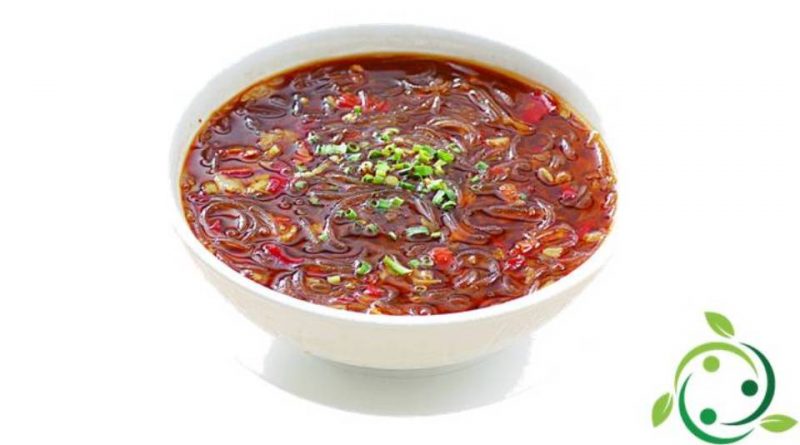Málà Sauce
Málà Sauce
The málà sauce (in Chinese 麻辣) is a renowned spiced Chinese sauce obtained with the use of Sichuan pepper, chilli pepper and various spices on a low heat with oil.
Origins and History –
The term málà is a combination of two Chinese characters: “numb” (麻) and “spicy” (辣), referring to the sensation it causes in the mouth. Numbness (or paraesthesia) is caused by Sichuan pepper which contains 3% alpha-hydroxy sanshool, a substance that, through the stimulation of some sensory receptors, can simulate the sensation of a slight electric shock.
For the preparation of this spice, dried red chillies are often used which are less spicy than the Thai chilli, much more common in Southeast Asian cuisine and other spices boiled with oil.
The málà sauce is considered as a regional dish for the cuisine of Chongqing (large city located at the confluence of the Blue and Jialing rivers, in southwest China) and the cuisine of Sichuan (province of Southwestern China, crossed by a stretch Yangtze, the longest river in Asia) and has become one of the most popular sauces in Chinese cuisine and has also generated many regional variations.
The precise origins of this spice are unclear; according to many sources, its creation and diffusion is attributable to the development of Chongqing night markets frequented by dock workers between the 19th and 20th centuries.
The strong flavor of the málà sauce and the thick layer of oil helps to preserve food and removes some bad smells of cheap food, such as solidified blood, beef, stomach and kidneys, which are usually served to dock workers.
Despite this sauce, in itself it has a strong flavor, it is used, in many variations, to make the consistency of cooked meat smooth and oily, and more complex tastes.
Typically these sauces, in their variations, are composed of sesame oil with garlic, oyster oil, or Doufu ru (a kind of pickled tofu, where tofu (in Chinese 豆腐 S, dòufǔP; in Japanese 豆腐 tōfu?) it is a kind of seed rennet (soybean), a food widespread in almost all the Far East (China, Japan, Korea, Vietnam, Thailand, Cambodia).
Description –
The málà sauce is a Chinese mixture of spices in sauce, spicy, and paralyzing that contains Sichuan pepper, chili pepper and various spices (with many variations) cooked over low heat with oil.
The sauce is mainly made from dried chilli, powdered chilli, douban paste, Sichuan pepper, cloves, garlic, star anise, black cardamom, fennel, ginger, cinnamon, salt and sugar. However, there are numerous variations and proportions of the various spices that make it up.
The appearance is that of a predominantly dark red, oily, more or less dense sauce due to the processing and composition of the various spices.
Active principles –
The nutritional values of the málà sauce are linked to the percentages that are used of the individual components which, as is evident, depends very much on the starting raw materials, so there is no standard data sheet of the nutritional values and substances present in this spice.
This is due not so much to the variability of the components, which in the málà sauce mixture are used in somewhat standard percentages, but for the variety of the ingredients and also for the difference in characteristics, often of the spices that compose it as they also come from somewhat different cultivation.
Obviously for the composition of the individual spices, please refer to the data sheet.
Properties and Uses –
Due to its particular composition, málà sauce, in addition to its spiciness, can cause the numbness that is caused by Sichuan pepper, which, as mentioned, contains 3% hydroxy-alpha-sanshool.
The recipe, as mentioned, can have many variations, such as the use of spicy chillies of various origins and varieties, linked to the various cuisines of Southeast Asia.
The málà sauce is used in a variety of ways: from sautées, to stews, to soups or used in very hot pots where various foods are immersed to be flavored.
In Sichuan and Yunnan (province located in southwest China, with a varied territory ranging from snow-capped mountains, terraced rice fields, lakes and deep gorges.), Which are among the major provinces of China where this is used particular spicy sauce, this is used on snacks and street foods, such as tofu, fried and barbecued potatoes, meat and vegetables.
For its particular processing, the restaurants that adopt this sauce hire specialized chefs who then use it in recipes that have often been kept secret.
Today, prepared mala sauce can easily be found in supermarkets and restaurant chains which often produce their own sauce on a large scale.
As is the case with curry, there is also a constant debate about who knows how to prepare the best recipe and, obviously, nobody withdraws from his position.
Preparations –
Different spices can be chosen for the preparation of the mala sauce, but generally the following are used:
– Dried chillies, chilli powder, douban paste (another salty and spicy sauce with the consistency of a paste), Sichuan pepper, cloves, garlic, star anise, black cardamom, fennel, ginger, cinnamon, salt and sugar. These ingredients are boiled with beef and vegetable oils for many hours, and then stored or packaged in jars. Other herbs and spices, such as ground ginger, Angelica dahurica and poppy seeds, can be added to create a more particular flavor.
This mala sauce, thus obtained, can be used in many dishes, including:
– Mala-sao-kao (麻辣 烧烤); with grilled pork, squid, prawns, chicken, sausage, orinji mushrooms, enoki, corn with spicy sauce.
– to cook grilled, fried or stir-fried dishes with noodles.
– Meat dishes seared in soups (麻辣烫 Mala-Tang) and hot dishes (麻辣 火锅 Mala-Huo-guo), and so on.
In general, however, málà sauce is used, especially in a more western cuisine to season dishes cooked on the barbecue.
Guido Bissanti
Warning: The information shown is not medical advice and may not be accurate. The contents are for illustrative purposes only and do not replace medical advice.

